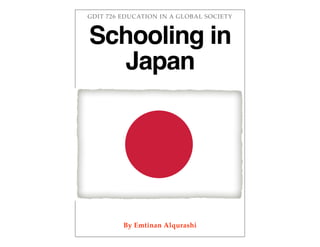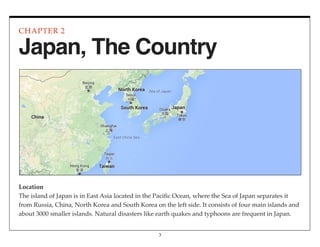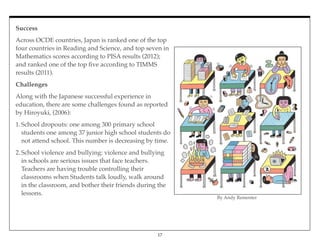The document provides an overview of schooling in Japan. It discusses that Japan has a highly successful education system as evidenced by high PISA and TIMSS test scores. The school system is structured with preschool, primary education from ages 6-12, and lower secondary from 12-15 which is compulsory. Upper secondary and higher education are available but not compulsory. Schools emphasize traditional values like cleaning and respect alongside academics. Teachers play an important social role. While the system is successful, challenges include bullying, lack of student interest at higher levels, and high teacher workload. Debates discuss balancing standardized testing with personality development.








![CHAPTER 4
8
Schooling
This video introduces the Japanese schooling
Source: Evans, A. [Where's Andrew?] (2011) https://youtu.be/5A09HhxXht4
Movie 4.1 Schools in Japan](https://image.slidesharecdn.com/japan-160217171150/85/726-Japan-9-320.jpg)










![xix
References
• Hiroyuki N. (2006). Japanese Schooling. In Mazurek, K., & Winzer, M. A. (Eds). Schooling around the world: De-
bates, challenges and practice. New York, NY: Pearson Education.
• Evans, A. [Where's Andrew?]. (2011, Sep 24). School in Japan [video file] Retrieved from:
https://youtu.be/5A09HhxXht4
• OECD Programme for International Students Assessments (2012). PISA 2012 Results: What students know and
can do: Student performance in mathematics, reading, and science. Retrieved from
http://www.oecd.org/pisa/home/
• Kisala, Robert (2005). Wargo, Robert, ed. The Logic Of Nothingness: A Study of Nishida Kitarō. University of Ha-
waii Press. pp. 3–4.
• Worldometers. (2016). Retrieved from http://www.worldometers.info/world-population/japan-population/
• The World Bank. Retrieved from http://data.worldbank.org/indicator/NY.GDP.PCAP.CD
• UNESCO. (2006). Japan. Retrieved from
http://www.ibe.unesco.org/fileadmin/user_upload/archive/Countries/WDE/2006/ASIA_and_the_PACIFIC
/Japan/Japan.htm
• US Department of State. (2015) U.S. Relations With Japan. Retrieved from
http://www.state.gov/r/pa/ei/bgn/4142.htm](https://image.slidesharecdn.com/japan-160217171150/85/726-Japan-20-320.jpg)